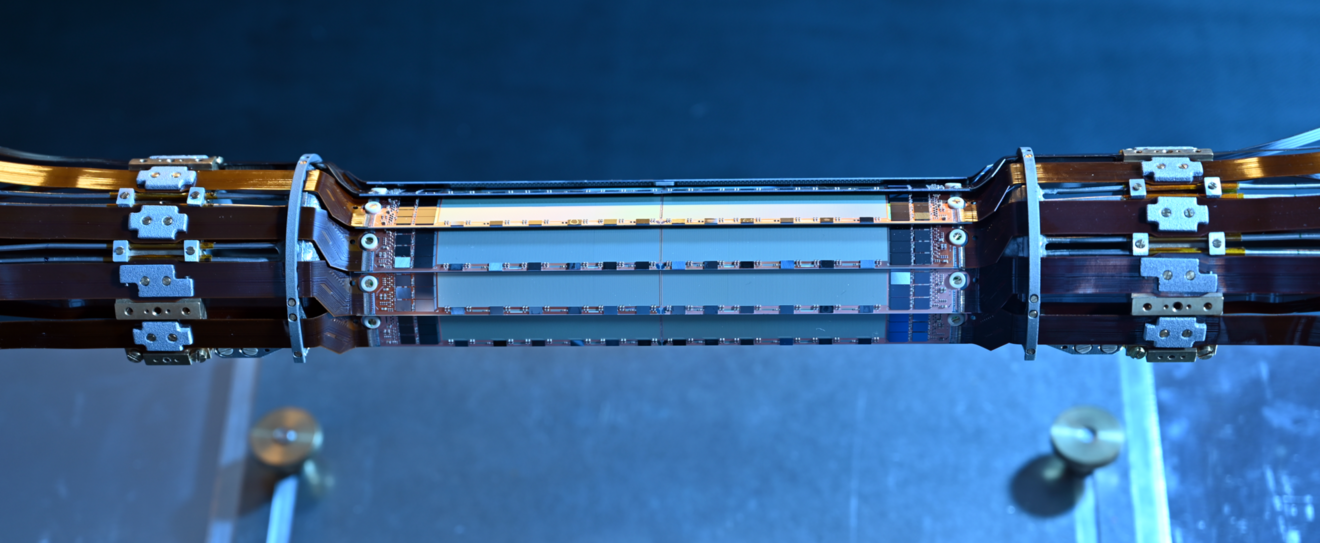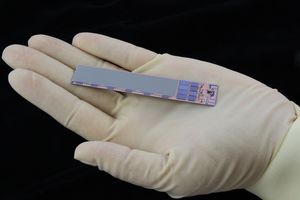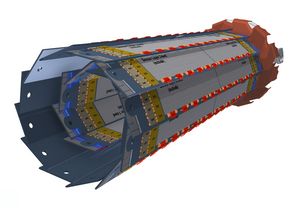Belle II: A pixel vertex detector for an updated accelerator
To exploit the potential of the new SuperKEKB accelerator, the existing Belle detector needed to be improved. In comparison to its predecessor, SuperKEKB has a significantly higher luminosity: That means more particles encountered each other per unit time and area. With that, the radiation load also increases, along with the number of background events and the data volume that the detector needs to process.
For the new detector Belle II, many components were changed out for new, improved replacements. This is especially true for the central track detectors. These reconstruct the tracks of charged particles originating from the the decay of B mesons. Thus the respective momenta and the point of decay (vertex) can be measured. The B mesons decay after an average flight distance of just 0.1 millimeters inside the beam pipe. In order to determine this spot precisely, the tracks recorded outside the beam tube have to be traced back.
For that, Belle II employs 40 silicon pixel sensors that are arranged cylindrically in two layers around the beam tube (1.4 and 2.2 centimeters away from the beam). The entire pixel vertex detector is the size of a soda can. Because particles are scattered during their transit through material, these detectors have to be very thin. Moreover, the track density in this region is markedly high as a result of background events: In one second, we record 1 million particles per square centimeter. That means the detector is constantly busy dealing with irrelevant events. To rapidly make the detector "free" again, one needs as many and as small pixels as possible, which can be read out extremely quickly.

Hair-fine sensors for highly accurate measurements

To achieve these goals, the Belle II researchers are working with a special pixel sensor. It is based on so-called DEPFET technology.
DEPFET detectors are very sensitive and fast: Around 100 nanoseconds is enough time to detect a particle. The pixel size is roughly 50 by 75 micrometers. In all, the detector has eight million pixels and generated 50,000 images per second. In that the detector was similar to CMOS sensors such as those used in modern digital cameras – with the difference, however, that it is sensitive not to visible light but rather to ionized particles, and it allows a far higher image frequency.
Since with DEPFETs only a small amount of silicon os needed for a sufficiently large signal, the sensors' thickness could be reduced to 75 micrometers – that is, literally a hair's breadth. Classical silicon sensors are around 300 micrometers thick. Because the DEPFET pixels themselves amplify the primary signal, additional electronic components could be dispensed with, along with extra material. Thanks to the DEPFET technology, the sensor – for all of its complexity – is extremely thin: thus preventing the measurement of particle tracks from being unduly distorted by the sensor material.
Fundamentals of DEPFET technology
The DEPFET technology was invented and developed for production at the MPP and the MPG Halbleiterlabor (HLL), the semiconductor laboratory of the Max Planck Society. DEPFET stands for depleted p-channel field-effect transistor. One p-channel field-effect transistor is placed in each pixel. In addition to the normal transistor gate, the DEPFET also has a so-called internal gate. This is a special region, underneath the transistor channel, in which all charges generated through ionization in the silicon are gathered. If a DEPFET pixel is hit by a charged particle, electrons are produced through ionization, and these drift into the internal gate. The accumulated charge alters the transistor current. This signal is measured – and indicates which pixel has been hit.
Scientists at the MPP and other research institutions have been working on the track detector since 2008. To get from the DEPFET principle to a usable detector, a huge development effort was necessary: The detector modules had to be designed in such a way that, despite the thin material, they would be sufficiently stable. To that end, the designers developed a mechanical support that cools the detector and doesn't require additional material.
Another distinctive feature of the DEPFET sensor is the ability to switch to a protective "unseeing" mode for several hundreds of nanoseconds. Like the electronic shutter of a camera, this feature prevents the sensor from becoming saturated or "blinded" in the event of a high signal concentration. This is the case in some particular operating modes of the SuperKEKB accelerator, in which extremely high levels of background events are generated.
Thanks to the DEPFET technology, Belle II is being equipped with one of the most modern, one of the fastest, and above all one of the thinnest vertex detectors ever developed for particle physics.
Subdetectors in Belle II
The pixel vertex detector was built by 11 German research institutions. Besides the innermost track detector, five more subsystems are at work in Bell II to record the trajectory, energy, charge, and momentum of the particle tracks. From this information it is possible to reconstruct which particles were generated by the collision of matter and antimatter – electrons and positrons – and how they decayed. Ultimately, these data should shed light on why there is matter in the universe, but no antimatter.
